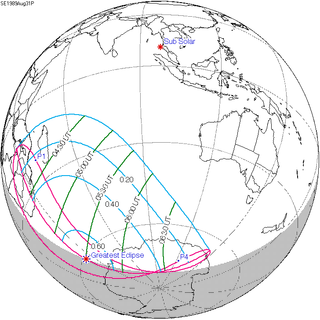Solar eclipse of August 31, 1989
| Solar eclipse of August 31, 1989 | |
|---|---|
 Map | |
| Type of eclipse | |
| Nature | Partial |
| Gamma | -1.1928 |
| Magnitude | 0.6344 |
| Maximum eclipse | |
| Coordinates | 61°18′S 23°36′E / 61.3°S 23.6°E |
| Times (UTC) | |
| Greatest eclipse | 5:31:47 |
| References | |
| Saros | 154 (5 of 71) |
| Catalog # (SE5000) | 9485 |
A partial solar eclipse occurred on August 31, 1989. A solar eclipse occurs when the Moon passes between Earth and the Sun, thereby totally or partly obscuring the image of the Sun for a viewer on Earth. A partial solar eclipse occurs in the polar regions of the Earth when the center of the Moon's shadow misses the Earth.
Related eclipses[]
Eclipses of 1989[]
- A total lunar eclipse on February 20.
- A partial solar eclipse on March 7.
- A total lunar eclipse on August 17.
- A partial solar eclipse on August 31.
Solar eclipses of 1986–1989[]
There were 8 solar eclipses between April 9, 1986 and August 31, 1989.
| Solar eclipse series sets from 1986–1989 | ||||||
|---|---|---|---|---|---|---|
| Ascending node | Descending node | |||||
| Saros | Map | Gamma | Saros | Map | Gamma | |
| 119 |  1986 April 9 Partial |
-1.08215 | 124 |  1986 October 3 Hybrid |
0.99305 | |
| 129 |  1987 March 29 Hybrid |
-0.30531 | 134 |  1987 September 23 Annular |
0.27869 | |
| 139 |  1988 March 18 Total |
0.41879 | 144 |  1988 September 11 Annular |
-0.46811 | |
| 149 |  1989 March 7 Partial |
1.09815 | 154 |  1989 August 31 Partial |
-1.19279 | |
Metonic series[]
The metonic series repeats eclipses every 19 years (6939.69 days), lasting about 5 cycles. Eclipses occur in nearly the same calendar date. In addition, the octon subseries repeats 1/5 of that or every 3.8 years (1387.94 days).
| 22 eclipse events, progressing from north to south between April 8, 1902, and August 31, 1989: | ||||
|---|---|---|---|---|
| April 7–8 | January 24–25 | November 12 | August 31-September 1 | June 19–20 |
| 108 | 114 | 116 | ||
 April 8, 1902 |
 August 31, 1913 |
 June 19, 1917 | ||
| 118 | 120 | 122 | 124 | 126 |
 April 8, 1921 |
 January 24, 1925 |
 November 12, 1928 |
 August 31, 1932 |
 June 19, 1936 |
| 128 | 130 | 132 | 134 | 136 |
 April 7, 1940 |
 January 25, 1944 |
 November 12, 1947 |
 September 1, 1951 |
 June 20, 1955 |
| 138 | 140 | 142 | 144 | 146 |
 April 8, 1959 |
 January 25, 1963 |
 November 12, 1966 |
 August 31, 1970 |
 June 20, 1974 |
| 148 | 150 | 152 | 154 | |
 April 7, 1978 |
 January 25, 1982 |
 November 12, 1985 |
 August 31, 1989 | |
References[]
External links[]
- Earth visibility chart and eclipse statistics Eclipse Predictions by Fred Espenak, NASA/GSFC
Categories:
- Partial solar eclipses
- 1989 in science
- 20th-century solar eclipses
- August 1989 events
- Solar eclipse stubs



